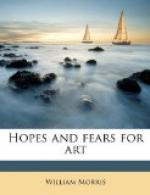Furthermore, you must not only mean something in your patterns, but must also be able to make others understand that meaning. They say that the difference between a genius and a madman is that the genius can get one or two people to believe in him, whereas the madman, poor fellow, has himself only for his audience. Now the only way in our craft of design for compelling people to understand you is to follow hard on Nature; for what else can you refer people to, or what else is there which everybody can understand?—everybody that it is worth addressing yourself to, which includes all people who can feel and think.
Now let us end the talk about those qualities of invention and imagination with a word of memory and of thanks to the designers of time past. Surely he who runs may read them abundantly set forth in those lesser arts they practised. Surely it had been pity indeed, if so much of this had been lost as would have been if it had been crushed out by the pride of intellect, that will not stoop to look at beauty, unless its own kings and great men have had a hand in it. Belike the thoughts of the men who wrought this kind of art could not have been expressed in grander ways or more definitely, or, at least, would not have been; therefore I believe I am not thinking only of my own pleasure, but of the pleasure of many people, when I praise the usefulness of the lives of these men, whose names are long forgotten, but whose works we still wonder at. In their own way they meant to tell us how the flowers grew in the gardens of Damascus, or how the hunt was up on the plains of Kirman, or how the tulips shone among the grass in the Mid-Persian valley, and how their souls delighted in it all, and what joy they had in life; nor did they fail to make their meaning clear to some of us.
But, indeed, they and other matters have led us afar from our makeshift house, and the room we have to decorate therein. And there is still left the fireplace to consider.
Now I think there is nothing about a house in which a contrast is greater between old and new than this piece of architecture. The old, either delightful in its comfortable simplicity, or decorated with the noblest and most meaning art in the place; the modern, mean, miserable, uncomfortable, and showy, plastered about with wretched sham ornament, trumpery of cast-iron, and brass and polished steel, and what not—offensive to look at, and a nuisance to clean—and the whole thing huddled up with rubbish of ash-pan, and fender, and rug, till surely the hearths which we have been bidden so often to defend (whether there was a chance of their being attacked or not) have now become a mere figure of speech the meaning of which in a short time it will be impossible for learned philologists to find out.




